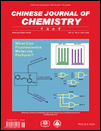Carboalumination-Epoxide Ring Opening for the Formation of 1,4-Disubstituted (Z)-3,6-Alkadienols
Corresponding Author
Quan Zhang
College of Pharmacy, State Key Laboratory of Elemento-Organic Chemistry, and Tianjin Key Laboratory of Molecular Drug Research, Nankai University, Tianjin 300071, China
College of Pharmacy, State Key Laboratory of Elemento-Organic Chemistry, and Tianjin Key Laboratory of Molecular Drug Research, Nankai University, Tianjin 300071, China, Tel.: 0086-022-23508090Search for more papers by this authorYuhuan Jing
College of Pharmacy, State Key Laboratory of Elemento-Organic Chemistry, and Tianjin Key Laboratory of Molecular Drug Research, Nankai University, Tianjin 300071, China
Search for more papers by this authorDavid C. Myles
Kosan Biosciences, Inc., 3832 Bay Center Place, Hayward, California 94545, USA
Search for more papers by this authorYong Li
Kosan Biosciences, Inc., 3832 Bay Center Place, Hayward, California 94545, USA
Search for more papers by this authorYue Chen
College of Pharmacy, State Key Laboratory of Elemento-Organic Chemistry, and Tianjin Key Laboratory of Molecular Drug Research, Nankai University, Tianjin 300071, China
Search for more papers by this authorCorresponding Author
Quan Zhang
College of Pharmacy, State Key Laboratory of Elemento-Organic Chemistry, and Tianjin Key Laboratory of Molecular Drug Research, Nankai University, Tianjin 300071, China
College of Pharmacy, State Key Laboratory of Elemento-Organic Chemistry, and Tianjin Key Laboratory of Molecular Drug Research, Nankai University, Tianjin 300071, China, Tel.: 0086-022-23508090Search for more papers by this authorYuhuan Jing
College of Pharmacy, State Key Laboratory of Elemento-Organic Chemistry, and Tianjin Key Laboratory of Molecular Drug Research, Nankai University, Tianjin 300071, China
Search for more papers by this authorDavid C. Myles
Kosan Biosciences, Inc., 3832 Bay Center Place, Hayward, California 94545, USA
Search for more papers by this authorYong Li
Kosan Biosciences, Inc., 3832 Bay Center Place, Hayward, California 94545, USA
Search for more papers by this authorYue Chen
College of Pharmacy, State Key Laboratory of Elemento-Organic Chemistry, and Tianjin Key Laboratory of Molecular Drug Research, Nankai University, Tianjin 300071, China
Search for more papers by this authorAbstract
Allylalumination of alkynes (i.e. forming Negishi's (Z)-alkenyl dialkylalane) followed by alkenylation of epoxides provides 1,4-disubstituted (Z)-3,6-alkadienols. The alkenylation can be facilitated by the presence of a neighbouring coordinating group in the epoxides. This "one-pot" approach has been successfully applied in the large-scale production of C10–C15 fragment of 9,10-didehydroepothilone D (a synthetic epothilone analog as an anti-cancer agent in phase 2 clinical trials).
Supporting Information
As a service to our authors and readers, this journal provides supporting information supplied by the authors. Such materials are peer reviewed and may be re-organized for online delivery, but are not copy-edited or typeset. Technical support issues arising from supporting information (other than missing files) should be addressed to the authors.
| Filename | Description |
|---|---|
| cjoc_201300235_sm_suppl.pdf419.7 KB | suppl |
Please note: The publisher is not responsible for the content or functionality of any supporting information supplied by the authors. Any queries (other than missing content) should be directed to the corresponding author for the article.
REFERENCES
- 1a Miyashita, M.; Hoshino, M.; Yoshikoshi, A.. J. Org. Chem., 1991, 56, 6483.
- 1b Sasaki, M.; Tanino, K.; Miyashita, M.. J. Org. Chem., 2001, 66, 5388.
- 1c Roush, W. R.; Adam, M. A.; Pesekis, S. M.. Tetrahedron Lett., 1983, 24, 1377.
- 1d Liu, C.; Hashimoto, Y.; Saigo, K.. Tetrahedron Lett., 1996, 37, 6177.
- 2a Wipf, P.; Lim, S.. Angew. Chem., Int. Ed., 1993, 32, 1068.
- 2b Pommier, A.; Stepanenko, V.; Jarowicki, K.; Kocienski, P. J.. J. Org. Chem., 2003, 68, 4008.
- 3a Fujiwara, T.; Yanai, K.; Shimane, K.; Takamori, M.; Takeda, T.. Eur. J. Org. Chem., 2001, 155.
- 3b Taylor, R. E.; Chen, Y.. Org. Lett., 2001, 3, 2221.
- 3c Rivkin, A.; Njardarson, J. T.; Biswas, K.; Chou, T.-C.; Danishefsky, S. J.. J. Org. Chem., 2002, 67, 7737.
- 3d Yokokawa, Y.; Kobayashi, K.; Yokoyama, M.; Yamamura, S.. Chem. Lett., 2003, 844.
- 3e Gaich, T.; Mulzer, J.. Org. Lett., 2005, 7, 1311.
- 4 Miller, J. A.; Negishi, E.-I.. Tetrahedron Lett., 1984, 25, 5863.
- 5a Rivkin, A.; Yoshimura, F.; Gabarda, A. E.; Chou, T.-C.; Dong, H.; Tong, W. P.; Danishefsky, S. J.. J. Am. Chem. Soc., 2003, 125, 2899.
- 5b Chappell, M. D.; Stachel, S. J.; Lee, C. B.; Danishefsky, S. J.. Org. Lett., 2000, 2, 1633.
- 6a Yoshimura, F.; Rivkin, A.; Gabarda, A. E.; Chou, T.-C.; Dong, H. J.; Sukenick, G.; Morel, F. F.; Taylor, R. E.; Danishefsky, S. J.. Angew. Chem., Int. Ed., 2003, 42, 2518.
- 6b Stopeck, A.; Thomas, E.; Jones, S.; Cohen, J.; Cropp, G.; Zhou, Y.; Feng, L.; Kersey, K.; Hannah, A. L.; Burris, H.. J. Clin. Oncol., 2006, 24(18S), 2041.
- 7 Groarke, M.; McKervey, M. A.; Miel, H.; Nieuwenhuyzen, M.. Org. Lett., 2000, 2, 2393.
- 8 Paterson, I.; Doughty, V. A.. Tetrahedron Lett., 1999, 40, 393.
- 9 Chen, Y.; Li, Y., WO 2009064800 Chem. Abstr., 2009, 150, 539476.




